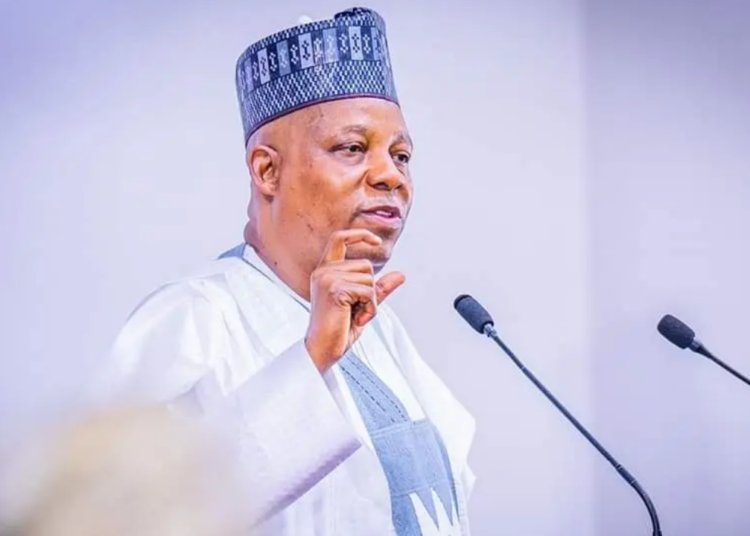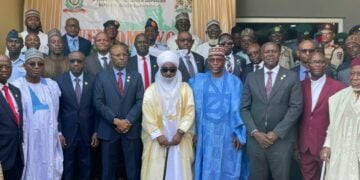The federal government has expressed concern over the devastating human and economic toll of malnutrition in Nigeria, revealing that the country loses an estimated $56 billion annually in human capital, equivalent to about 12.2 per cent of its national income.
Vice President Kashim Shettima stated this on Thursday at the Conference on Mobilising Against Malnutrition in North-West Nigeria, hosted by the Katsina State Government in collaboration with the North-West Governors’ Forum, Médecins Sans Frontières (MSF), and the Office of the Vice President, held in Abuja.
Shettima said the figures represented more than economic loss, they captured lost potential, unfulfilled dreams, and a cycle of poverty that undermines development.
“Every year, thousands of our children and pregnant women lose their lives to malnutrition-related causes. Millions more are left physically and mentally diminished. When a nation’s child suffers from stunted growth, its future becomes stunted. When a mother lacks the nutrition to sustain herself and her unborn child, it is not her failure, it is a collective indictment on our social system,” he said.
Represented by the Senior Special Assistant to the President on Public Health, Mrs Uju Rochas-Anwukah, the Vice President stressed that nutrition should not be viewed as a cost but as an investment with one of the highest returns in development – $23 for every dollar spent.
“Treating malnourished children saves lives, while preventing malnutrition helps them grow, learn, and thrive. Because no child can learn on an empty stomach,” Shettima said, urging partners to move from “awareness to action.”
The Vice President highlighted the federal government’s Nutrition 774 Initiative and Accelerating Nutrition Results in Nigeria (ANRIN 2.0) project as evidence of renewed leadership and decentralised nutrition governance.
These programmes, he explained, were anchored on five key pillars; political leadership, sustainable financing, multi-sectoral coordination, accountability, and evidence-based planning.
“No government can solve this crisis alone. Nutrition is not charity, it is enlightened self-interest. A nourished child is a future innovator, teacher, and leader,” he added.
In his remarks, the Katsina State governor, Dikko Umar Radda, said malnutrition had become an emergency threatening the future of children in the North-West. He revealed that his administration had invested heavily in healthcare, agriculture, and social protection to tackle the crisis.
Radda said over ₦40 billion had been invested in the health sector, 261 primary health centres renovated, and 2,977 health workers employed. He also revealed that Katsina State contributed ₦1 billion to the Child Nutrition Fund, matched by UNICEF, and distributed 90,000 bags of grains to vulnerable households.
“When the MSF report came out, it was daunting, but instead of rejecting it, we took it as a challenge. We are confronting the situation head-on,” the governor said.
He disclosed that the state was setting up a local Ready-to-Use Therapeutic Food (RUTF) production facility to ensure sustainable supply for malnutrition treatment centres, while also implementing six-month maternity leave and child protection laws to improve child health and nutrition outcomes.
The Coordinating Minister of Health and Social Welfare, Prof. Ali Pate, described malnutrition as “one of the most pressing challenges confronting Nigeria,” especially in the northwest, where wasting and stunting levels exceed emergency thresholds.
Represented by the Director of Nutrition at the ministry, Mrs. Ladidi Bako-Aiyegbusi, he revealed that the federal government had established 115 new treatment sites this year and was scaling up both preventive and treatment interventions under the National Food and Nutrition Policy.
“Behind every statistic is a real child and a real family struggling to survive. Government alone cannot carry this burden. We must all act, states, donors, civil society, and communities,” he said.
Data presented at the conference showed that stunting rates in the North-West range from 40.7 per cent in Kebbi to 64.6 per cent in Katsina, with the region collectively losing over ₦1 trillion in GDP annually due to malnutrition.
Nigeria remains at the epicentre of a worsening child malnutrition crisis, with MSF revealing that it treated nearly 300,000 children suffering from Severe Acute Malnutrition (SAM) across northern Nigeria in 2024, the highest number for any country where the organisation operates.
MSF Country Representative, Dr. Ahmed Aldikhari, said the figure accounted for more than half of MSF’s global SAM admissions, underscoring the severity of Nigeria’s malnutrition burden and the urgent need for joint action.
He noted that the situation is particularly dire in northwestern and Sahelian regions, where seasonal hunger, food insecurity, and inadequate access to healthcare continue to drive up malnutrition rates among children and pregnant women.





